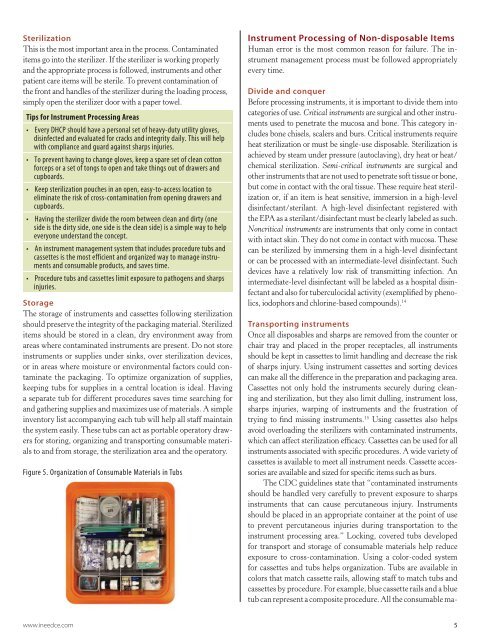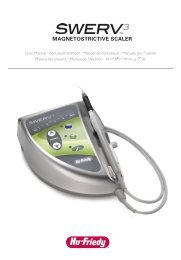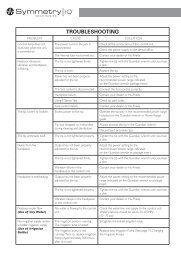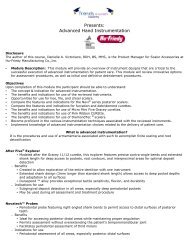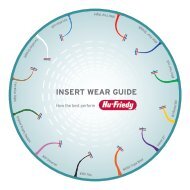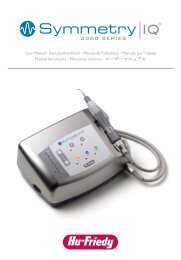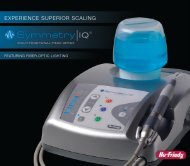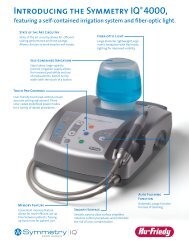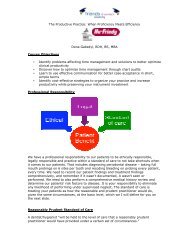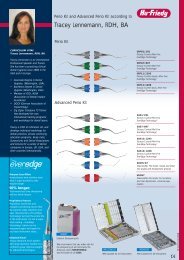Effective and Productive Instrument Processing - Friends of Hu-Friedy
Effective and Productive Instrument Processing - Friends of Hu-Friedy
Effective and Productive Instrument Processing - Friends of Hu-Friedy
Create successful ePaper yourself
Turn your PDF publications into a flip-book with our unique Google optimized e-Paper software.
Sterilization<br />
This is the most important area in the process. Contaminated<br />
items go into the sterilizer. If the sterilizer is working properly<br />
<strong>and</strong> the appropriate process is followed, instruments <strong>and</strong> other<br />
patient care items will be sterile. To prevent contamination <strong>of</strong><br />
the front <strong>and</strong> h<strong>and</strong>les <strong>of</strong> the sterilizer during the loading process,<br />
simply open the sterilizer door with a paper towel.<br />
Tips for <strong>Instrument</strong> <strong>Processing</strong> Areas<br />
• Every DHCP should have a personal set <strong>of</strong> heavy-duty utility gloves,<br />
disinfected <strong>and</strong> evaluated for cracks <strong>and</strong> integrity daily. This will help<br />
with compliance <strong>and</strong> guard against sharps injuries.<br />
• To prevent having to change gloves, keep a spare set <strong>of</strong> clean cotton<br />
forceps or a set <strong>of</strong> tongs to open <strong>and</strong> take things out <strong>of</strong> drawers <strong>and</strong><br />
cupboards.<br />
• Keep sterilization pouches in an open, easy-to-access location to<br />
eliminate the risk <strong>of</strong> cross-contamination from opening drawers <strong>and</strong><br />
cupboards.<br />
• Having the sterilizer divide the room between clean <strong>and</strong> dirty (one<br />
side is the dirty side, one side is the clean side) is a simple way to help<br />
everyone underst<strong>and</strong> the concept.<br />
• An instrument management system that includes procedure tubs <strong>and</strong><br />
cassettes is the most efficient <strong>and</strong> organized way to manage instruments<br />
<strong>and</strong> consumable products, <strong>and</strong> saves time.<br />
• Procedure tubs <strong>and</strong> cassettes limit exposure to pathogens <strong>and</strong> sharps<br />
injuries.<br />
Storage<br />
The storage <strong>of</strong> instruments <strong>and</strong> cassettes following sterilization<br />
should preserve the integrity <strong>of</strong> the packaging material. Sterilized<br />
items should be stored in a clean, dry environment away from<br />
areas where contaminated instruments are present. Do not store<br />
instruments or supplies under sinks, over sterilization devices,<br />
or in areas where moisture or environmental factors could contaminate<br />
the packaging. To optimize organization <strong>of</strong> supplies,<br />
keeping tubs for supplies in a central location is ideal. Having<br />
a separate tub for different procedures saves time searching for<br />
<strong>and</strong> gathering supplies <strong>and</strong> maximizes use <strong>of</strong> materials. A simple<br />
inventory list accompanying each tub will help all staff maintain<br />
the system easily. These tubs can act as portable operatory drawers<br />
for storing, organizing <strong>and</strong> transporting consumable materials<br />
to <strong>and</strong> from storage, the sterilization area <strong>and</strong> the operatory.<br />
Figure 5. Organization <strong>of</strong> Consumable Materials in Tubs<br />
<strong>Instrument</strong> <strong>Processing</strong> <strong>of</strong> Non-disposable Items<br />
<strong>Hu</strong>man error is the most common reason for failure. The instrument<br />
management process must be followed appropriately<br />
every time.<br />
Divide <strong>and</strong> conquer<br />
Before processing instruments, it is important to divide them into<br />
categories <strong>of</strong> use. Critical instruments are surgical <strong>and</strong> other instruments<br />
used to penetrate the mucosa <strong>and</strong> bone. This category includes<br />
bone chisels, scalers <strong>and</strong> burs. Critical instruments require<br />
heat sterilization or must be single-use disposable. Sterilization is<br />
achieved by steam under pressure (autoclaving), dry heat or heat/<br />
chemical sterilization. Semi-critical instruments are surgical <strong>and</strong><br />
other instruments that are not used to penetrate s<strong>of</strong>t tissue or bone,<br />
but come in contact with the oral tissue. These require heat sterilization<br />
or, if an item is heat sensitive, immersion in a high-level<br />
disinfectant/sterilant. A high-level disinfectant registered with<br />
the EPA as a sterilant/disinfectant must be clearly labeled as such.<br />
Noncritical instruments are instruments that only come in contact<br />
with intact skin. They do not come in contact with mucosa. These<br />
can be sterilized by immersing them in a high-level disinfectant<br />
or can be processed with an intermediate-level disinfectant. Such<br />
devices have a relatively low risk <strong>of</strong> transmitting infection. An<br />
intermediate-level disinfectant will be labeled as a hospital disinfectant<br />
<strong>and</strong> also for tuberculocidal activity (exemplified by phenolics,<br />
iodophors <strong>and</strong> chlorine-based compounds). 14<br />
Transporting instruments<br />
Once all disposables <strong>and</strong> sharps are removed from the counter or<br />
chair tray <strong>and</strong> placed in the proper receptacles, all instruments<br />
should be kept in cassettes to limit h<strong>and</strong>ling <strong>and</strong> decrease the risk<br />
<strong>of</strong> sharps injury. Using instrument cassettes <strong>and</strong> sorting devices<br />
can make all the difference in the preparation <strong>and</strong> packaging area.<br />
Cassettes not only hold the instruments securely during cleaning<br />
<strong>and</strong> sterilization, but they also limit dulling, instrument loss,<br />
sharps injuries, warping <strong>of</strong> instruments <strong>and</strong> the frustration <strong>of</strong><br />
trying to find missing instruments. 15 Using cassettes also helps<br />
avoid overloading the sterilizers with contaminated instruments,<br />
which can affect sterilization efficacy. Cassettes can be used for all<br />
instruments associated with specific procedures. A wide variety <strong>of</strong><br />
cassettes is available to meet all instrument needs. Cassette accessories<br />
are available <strong>and</strong> sized for specific items such as burs.<br />
The CDC guidelines state that “contaminated instruments<br />
should be h<strong>and</strong>led very carefully to prevent exposure to sharps<br />
instruments that can cause percutaneous injury. <strong>Instrument</strong>s<br />
should be placed in an appropriate container at the point <strong>of</strong> use<br />
to prevent percutaneous injuries during transportation to the<br />
instrument processing area.” Locking, covered tubs developed<br />
for transport <strong>and</strong> storage <strong>of</strong> consumable materials help reduce<br />
exposure to cross-contamination. Using a color-coded system<br />
for cassettes <strong>and</strong> tubs helps organization. Tubs are available in<br />
colors that match cassette rails, allowing staff to match tubs <strong>and</strong><br />
cassettes by procedure. For example, blue cassette rails <strong>and</strong> a blue<br />
tub can represent a composite procedure. All the consumable ma-<br />
www.ineedce.com 5


